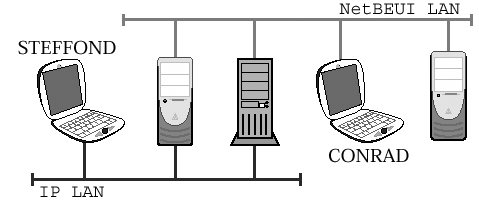| One of the most common and obvious problems, once you know what to look for, is a misconfigured host. Things that can go wrong include: The wrong workgroup name in the configuration Perhaps you entered " WROKGROPE " when you meant to type in " WEIMARANER ". Browser services disabled There are Windows restistry settings and Samba configuration settings that can prevent a node from becomming a Potential Browser. If there are no browser nodes on the LAN, then the Network Neighborhood will fade away like Brigadoon. Browser services over-enabled A node with its OS level or other criteria set too high can win elections over a node that is a better choice. A misconfigured or missing NBNS server address Local browsing will work fine without an NBNS, but cross-subnet browsing will fail. Proper NBNS (WINS) configuration is required for cross-subnet browsing. P mode In P mode, the Consumer must deal directly with the Domain Master Browser. That only works if there is a DMB, and the NBNS is configured correctly. In many cases, the Consumer node should really be running in H or M mode. User not authenticated Some client systems require that the user be logged on before they start SMB services. Also, some Browse Servers require authentication before they permit access to the NetServerEnum2 call. Prolific protocol bindings This is the biggie. In the old IBM/Sytec days there were these things called LANAs ( LAN A dapters). We would call them NICs ( N etwork I nterface C ards) today. The original NetBIOS software spoke directly to the LANAs so, logically, when you build an emulated NetBIOS LAN you also have virtual LANAs. On some systems, such as Windows, you can "bind" the NetBIOS layer to several different protocols. We have focused on NetBIOS over TCP/UDP/IP, but Windows can also bind NetBIOS to NetBEUI and to something called NWLink (which is Microsoft's implementation of Novell's IPX/SPX). Each binding represents another virtual LANA. That means that a Windows system with NetBIOS bound to multiple transport protocols is a multi- homed host, as shown in Figure 25.1. Figure 25.1. Multiple virtual networks A node with NetBIOS bound to two transport protocols is logically connected to two separate virtual NetBIOS LANs. Consider what happens when node STEFFOND wins the Browser Election on the IP LAN, after which node CONRAD calls for an election on the NetBEUI LAN and wins. The two nodes are not on the same (virtual) LAN, so they do not know that they are competing.  One potential result of this configuration is an election storm , in which the RequestElection frames keep getting sent out (via both virtual LANAs, in some cases) but there is never any clear winner, so the elections have to start all over again. The Leach/Naik Browser draft addresses this issue by warning that a broswer node must be aware of the separate virtual LANs to which it is connected. [1] [1] Do election storms really happen? I have heard reports of them, but never seen one first-hand.  | 